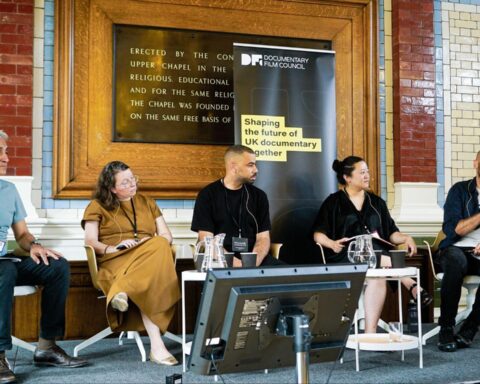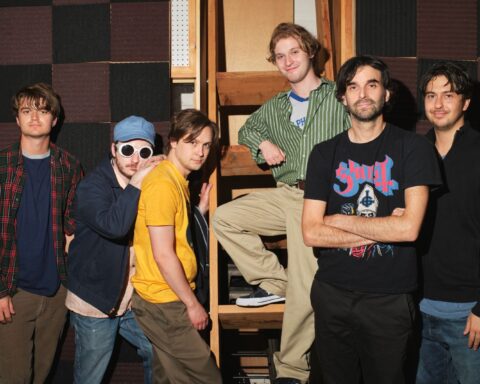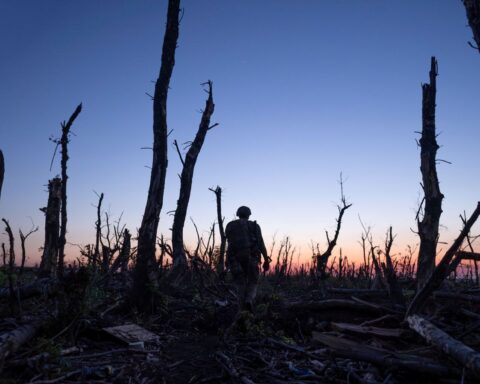The international film festival is a strange creation. Like documentary, it isn’t any one thing. Instead, it resembles a leaky holding tank, the contents of which constantly seep, form new bodies, expand, transform and otherwise confound precise categorization. It is an organism eschewing stasis: regardless of size, import or cultural capital, the festival must constantly be on the move in order to stay alive and offer surprises to its perennial spectators.
If one compares one of the earliest documentaries, L’arrivée d’un train en gare de la Ciotat by the Lumière brothers—first publicly screened in January 1896—to John Greyson’s complex political doc-opera Fig Trees, screened at Hot Docs in 2010, such itinerant qualities would seem to apply to the non-fiction film genre as well. It makes sense then, that two dynamic and increasingly popular media constellations, one bound up in time and space, the other transcending such restraints, would somehow converge in a global city like Toronto, and demand our attention. Such is the peppy and world-renowned international documentary film festival with the infectiously clever name Hot Docs. What follows is an attempt to understand this social phenomenon outside the purview of its films and filmmakers.
Hot Doc Time Machine
International film festivals emerged around 60 years ago as political and national entities feverishly assembled in various European cities to counter rival festivals sporting the wrong ideological feathers nestled in equally unfavourable countries. After several “new wave” and “emergent national cinema” declarations, Europe ceded its festival brood—by now its own continental network—to the forces of globalization and in the 1980s other parts of the planet harnessed the film festival spirit, including Sundance, Montreal, Hong Kong, Sydney, and Toronto. These new hotspots in the global culture of cinema showed a rebellious spirit in the face of ubiquitous Hollywood products, and indeed fought effectively (although few continue to) for a more diverse, independent, auteur-driven world cinema. It was a sprout-like phenomenon that would broach the holding tank further by not only boosting commercially unfriendly art house and independent cinema, but by carving out space for other niche iterations like documentary and ethnic-themed festivals.
Like most niche fests, Hot Docs emerged humbly at first. It was established by the Documentary Organization of Canada (then the Canadian Independent Film Caucus) in 1993 as an industry insider’s event (read: a diminutive group of documentarians dorking out on way too much caffeine). Initially, docs were shown at prosaic hotel conference rooms, and the technical feat of the day involved balancing television sets on chairs. In 1996 the festival had gained some traction and separately incorporated as its own charitable organization. It began attracting the kind of small crowds in cafés and cinemas in Little Italy that befits a nascent “niche” festival in an otherwise feature fiction–dominated mainstream film fest universe.
Niche festivals form from the clay of larger mixed-genre international fests for fairly predictable reasons: lack of representation at existing larger-scale events, abundance of overlooked quality work, and earnest and dedicated communities. These smaller festivals rescue alternative forms and genres from marginalization (“The World of African Cinema” at 8 AM, anyone?) as mainstream fests assert their power to set standards, taste-make, form canons, and draw lines of programming inclusion and exclusion. Among the motley crew of festival-neglected film and video, one finds the documentary, fiction’s twice-removed illegitimate cousin.
Documentary has percolated on the margins of the mainstream festival world for decades, despite holding the title of originator of all things filmic. Until the ’90s festivalgoers would be hard-pressed to find very many non-fiction nuggets whilst traversing the film fest circuit, adorned as it was with so much fiction fare (and fluff). Flash forward almost two decades and Hot Docs has outgrown the awkward stage, maturing in its late teens as the gangly but spirited and respected documentary film festival that is now the largest in North America (and second in the world only to Amsterdam’s mighty IDFA).
Audience attendance figures at Hot Docs continue to break records, with a whopping 136,000 bums settling into seats in 2010 (up from 68,000 only three years earlier). Last year’s edition saw 166 films from 40 countries screened 283 times in seven venues. While 1,818 delegates attended (670 from outside Canada), 20 fulltime staffers (and many more on contract) and 370 volunteers kept the machinery whirring as 409 buyers mingled about, ducking from some doc-makers and taking coveted meetings with others. No televisions were balanced on chairs and no espresso machines drowned out any soundtracks.
In all, the 17th edition of Hot Docs was a massive show of force regarding our niche criteria: many films were shown that weren’t to be found at other mixed-genre/mainstream film festivals, and an avid community of fans, makers, buyers, sellers, organizers and tastemakers assembled like a beautiful human-art car wreck for 11 exhilarating days.
But what can we take away from the event as a whole? Hot Docs can be described as many things: carnival, ritual, conference, showcase, ceremony, performance, business meeting, social space, art world, public sphere, bourgeois bacchanalia, corporate platform, emergent artist launching pad. With so many avenues it is instructive to organize thoughts into manageable categories. As such, I focus on two ever-present aspects that help to understand the role, function and context of this important cultural institution. Community and network are defining characteristics of all international film festivals, and they most certainly apply to Toronto’s forum for non-fiction cinema.
A Networked Community
Unlike an auto pile-up, Hot Docs has a purpose beyond facilitating the ancient act of spectatorship. Hot Docs, like all film festivals, forges community and, like most niche film festivals, celebrates, promotes and supports a marginalized cinematic culture and form. Documentary may be consecrated in some circles for breaking free from its co-dependent relationship with mainstream fiction—rising to lofty heights in popular imagination, media and taste—but outside the ephemeral festival it is still Mission Impossible to easily see documentaries in social settings (that is, in “meat space,” with other humans in the dark). Festivals like IDFA, DocLisboa, DOK Leipzig, DOXA, RIDM, Cph:dox and Hot Docs are conscious of this chasm between documentary production and reception, and besides delivering abundant doc goods to the public for short stints each year (and through extended festival projects that operate outside limited fest time spans such as Hot Docs’s Doc Soup) these non-fiction fests strengthen their ‘niche’ culture, industry and art by creating and maintaining a community.
It is a carefully controlled and managed community, of course, and hierarchies are established through programming, accreditation systems (signified by festival badges worn around the neck), and zones of inclusion and exclusion. Such restrictive strata have led Thomas Elsaesser to compare film festivals to airports, rather than “marketplaces and trade fairs.” Hot Docs constructs such hierarchies by corralling the “right” people together into spaces, often with complimentary food and drink, thus defining inner and outer circles of the international documentary “community” and building an architecture of exclusion and inclusion that is mostly predicated by cultural capital, celebrity/notoriety, proximity to power, and ability-to-pay.
Elements of exclusion/inclusion permeate the culture and can find their way from the architecture of the event into interpersonal exchanges. While attending Hot Docs some years ago, I had a festival experience akin to speed dating on steroids. I had been standing at a cocktail event in the glorious Royal Ontario Museum, frazzled from so many screenings that day and maybe even mumbling to myself. As I stood there taking the animated crowd in, various individuals frenetically approached me, making the bare-minimum eye contact needed to rule out sociopathy, and quickly scanned my “badge”—the coded pass slung round my neck. I can only surmise, but it seems to me that, upon reading my pass and learning of my “non-profit” and “grassroots” status (as the programmer for Cinema Politica), each person quickly vacated my space, some without even saying a word.
It was like being an unpopular dish at a fancy social: the bowl of potato salad set awkwardly among caramelized Pacific salmon skewers and avocado-mango purées. But, chin up! I learned to adapt and “work the room” like everyone else whose festival setting remains stuck on hyper-network-drive (mostly industry insiders). Perhaps this is a rite of passage for acceptance into the community of doc (and fest) dwellers.
Hot Docs has excelled in forging a networked community of professionals: artists, commissioning editors, distributors, programmers, acquisition executives and others who make up the nuts-and-bolts of the industry. The festival organizes an industry conference where, in 2010, sessions focused on everything from the creativity of the craft to distribution problems/solutions to online and interactive documentary. Kickstart, a workshop aimed at helping emerging filmmakers, divided a day into learning about Funding It, Making It, and Selling It, where the hardened veterans passed on knowledge to the wide-eyed newbies. Delegates spent another day exchanging global partnership know-how as part of International Co-production Day.
But the Toronto Documentary Forum (renamed Hot Docs Forum for the 2011 edition to alleviate confusion) is perhaps the most auspicious aspect of the market side of Hot Docs. A three-day intense meet-and-greet of doc industry types, the TDF (HDF) features a gladiator-style pitch session and a veritable rendezvous avalanche for various agents seeking to connect the crucial dots of financing, production, distribution and broadcasting. Rendezvous is in fact the name of a separate market event that “facilitates one-on-one meetings between independent filmmakers and international documentary financiers.” It is comprised of yet more meetings, succinctly pinched into strict 15-minute time slots pitting makers with buyers. Other “Micro Meetings” and “Network Events” abound.
All these meetings, events and carefully managed spaces help constitute a professional documentary community—and to be sure, Hot Docs is world-renowned for this business-networking aspect of the festival. However, the documentary industry community that convenes in Toronto every April does more than locate funds and connect productions with markets. It is part of a globally linked cultural force that contributes to documentary cinema’s evolution from obscurity in programming ghettos toward elusive primetime television and theatrical slots.
Communities as spread out as the international documentary community require spaces to congregate, share ideas, see each other’s work and rustle up dwindling resources. With tastemakers and policy-makers in such close proximity to artists and audiences, strange things can and do happen. At every Hot Docs edition I’ve attended I’ve met filmmakers who have made golden connections with individuals who can take their project to the next level, as they say. The festival also presents a great opportunity to apply pressure to cultural gatekeepers, as is the case of the European festivals muscling state broadcasters to diversify television content. With Canadian television envelopes closing faster than you can say American Idol, this latter aspect of the festival space is more crucial than ever.
Hot Docs is more than a community of industry insiders—it is a cultural institution that facilitates the linkage between a variety of communities, including activists of all stripes, cinephiles, festival enthusiasts, journalists, critics and artists, to name a few. Yochai Benkler has celebrated this kind of connectivity in what he calls the “new networked information economy.” In his book The Wealth of Networks, he writes that the most exciting aspect of our current historical moment is “the rise of individual practical capabilities, and the role that these new capabilities play in increasing the relative salience of non-proprietary, often non-market individual and social behavior.” That we live in increasingly deep networked times is not lost on Hot Docs organizers or anyone with a Facebook account—but how we harness and utilize such social connectivity toward accessible and open systems of exchange is the stuff of an exciting documentary future.
Film festivals like Hot Docs play an important role in how global skeins of art, culture, business and people will converge, collaborate and challenge 20th-century models of static institutions and top-down, centralized power structures. Hot Docs is part of a massive network of, according to the New York Times, over 1,000 film festivals. It is also a hub in the smaller network of documentary art, culture and business. North America’s largest doc showcase is a critical convergence point on a map that is continually redrawn and reinvented by the people traversing its terrain, and as such, it is a space of great import for not only cinema culture, but also the documentary community writ large.
It is the social aspect of Hot Docs that is often overlooked by media, industry insiders and even event organizers, and of course I am not referring to the industry meetings and food and drink extravaganzas—lord knows much attention is directed toward their proliferation. I’m speaking of the less visible but equally important social connections that are forged at the festival each and every year, outside of industry orientation. The myriad moments where cultural citizenship and political participation challenge conceptions of passive spectatorship are part of the brick and mortar that keeps fortress Hot Docs robust and indispensable.
One such “moment” took place in 2009 when filmmaker Shannon Walsh premiered her powerful political documentary about the Alberta tar sands, H2Oil, at Hot Docs. Loaded Pictures, the small Montreal-based collective behind the film, decided that sending the filmmakers to Toronto wasn’t good enough: instead, they packed a whole school bus with activists to make the seven-hour trip. The film screened in the Bloor Cinema and the audience was abuzz with the “What can we do?” questions, and Walsh let everyone know about other events going on in Toronto that had been organized in tandem with her film screening (such as the Environmental Aboriginal Network panel the next day). As audience members mingled in the lobby and on Bloor Street, I overheard several conversations that were framed by the prospects of post-screening action, including plans to attend the other events Walsh had mentioned. These “small moments” of connectivity and exchange define a public sphere of active audiences who may not be attending industry events or micro-meetings, but who nonetheless populate Hot Docs and help form the festival’s social shape.
Size Matters
As Hot Docs grows it is not without its critics, whose main complaints against the festival stem from its alienating enormity, its perceived focus on market over audience, and its corporate relationships. Valid concerns all of them, but they can be readily applied to any of the large international festivals, and one wonders if it is inevitable that the niche leak from the original European festival holding tank is merely drawing ire because it resembles the mainstream giants from which it sprang forth.
Surely a massive event that attracts precious public and media attention to a marginalized cinematic form like documentary is good for business and culture After all, the thought of 136,000 people turning up to see documentaries at any event was an absurd notion not too many years ago—one that became a triumphant reality at last year’s Hot Docs festival.
Still, producing bigger and bigger editions of Hot Docs requires more money, resources and compromises along the way. Things can fall through the cracks that are disloyal to the spirit of documentary as a dissenting voice in the mainstream media margins. Cadillac SUV ads were shown in 2006 before a doc about Ralph Nader (which led to a wonderful audience revolt of bike bells being rung as the ad played) and Coca-Cola was the environmental film sponsor in 2010 (“You’ve got to be kidding me” was what the elderly women sitting in front of us at one screening said when the Coke sponsorship flashed on the screen). But again, these are likely the inevitable consequences of a small niche fest growing into a large commercial fest. The trick for Hot Docs and other large film festivals is the difficult balancing act between community zest and commercial zeal (often characterized as art versus commerce).
In his rollicking chronicle of 25 years of TIFF, Brave Films Wild Nights, Brian D. Johnson writes, “[A]t any good party, eventually the guests take over. Once the festival is established, the story belongs to the filmmakers.” Hot Docs certainly belongs to the filmmakers, but it also belongs to industry dealmakers, eager audience members, determined activists, and everyone between. In other words, Hot Docs belongs to the documentary community. And as a member of that community, I hope that holding tank continues to leak in outstanding and outspoken ways.










